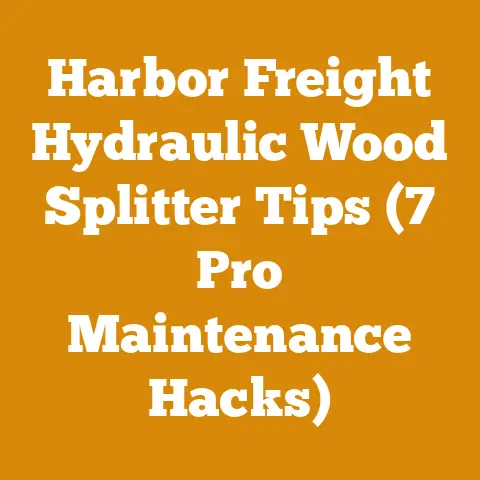Dead Mold on Wood (5 Pro Tips for Safe Removal)
Ever noticed how the most beautiful wood can sometimes sport a less-than-attractive green or black fuzz? Yeah, that’s mold, and it’s not just an aesthetic issue. I’ve seen firsthand how ignoring mold can turn a beautiful piece of lumber into a soft, crumbling mess. That’s why understanding how to safely remove it is crucial for anyone working with wood, whether you’re a seasoned carpenter or a weekend DIYer.
Dead Mold on Wood: 5 Pro Tips for Safe Removal
Mold on wood isn’t just unsightly; it can compromise the structural integrity of the wood and pose health risks. In this article, I’ll share five essential tips for safely removing dead mold from wood, drawing from my years of experience in woodworking and timber management. I’ll break down the science behind mold growth, the tools and techniques you’ll need, and, most importantly, how to protect yourself during the removal process. Let’s dive in and reclaim that beautiful wood!
Understanding Mold on Wood
Before we grab our cleaning supplies, let’s get a handle on what we’re dealing with. Mold isn’t just some random discoloration; it’s a living organism that thrives on organic materials, like wood.
What is Mold?
Mold is a type of fungus that grows in filaments and reproduces by releasing spores into the air. These spores are everywhere, both indoors and outdoors. They’re just waiting for the right conditions – moisture, warmth, and a food source – to start growing. Think of mold spores like seeds; they’re harmless until they land in fertile ground.
Why Does Mold Grow on Wood?
Wood, being an organic material, is a prime food source for mold. Here’s why:
- Moisture Content: Mold needs moisture to thrive. Wood that’s exposed to humidity, leaks, or condensation is a breeding ground for mold.
- Nutrients: Wood contains cellulose and lignin, which mold fungi break down for food.
- Temperature: Mold grows best in temperatures between 40°F and 100°F (4°C and 38°C), which is a pretty broad range that covers most indoor and outdoor environments.
Types of Mold Found on Wood
There are many types of mold that can grow on wood, each with its own characteristics. Here are a few common culprits:
- Aspergillus: Often appears as green or yellow spots.
- Cladosporium: Usually black or dark green, and one of the most common molds found both indoors and outdoors.
- Penicillium: Similar to Aspergillus, often blue-green in color.
- Stachybotrys Chartarum (Black Mold): This is the infamous “black mold” that gets a lot of attention. It’s greenish-black and slimy, and it’s often associated with serious water damage.
Personal Story: I once salvaged a pile of oak planks from an old barn. They were beautiful, but covered in a patchwork of green, black, and white mold. It looked like a Jackson Pollock painting gone wrong! I knew I had to identify the types of mold present to ensure I was using the right cleaning methods and taking the necessary safety precautions.
Distinguishing Between Dead and Alive Mold
This is crucial because the removal methods differ. Alive mold is actively growing and spreading, while dead mold is dormant.
- Alive Mold: Often appears slimy or fuzzy, and it may have a strong, musty odor. If you disturb it, you might see spores being released into the air.
- Dead Mold: Typically looks dry and powdery. It might still stain the wood, but it won’t be actively spreading.
Unique Insight: Even dead mold can pose health risks because it still contains allergens and toxins. So, don’t skip the safety precautions, even if you think the mold is dead.
Health Risks Associated with Mold Exposure
Exposure to mold can cause a variety of health problems, especially for people with allergies, asthma, or weakened immune systems. Common symptoms include:
- Respiratory problems (coughing, wheezing, shortness of breath)
- Skin irritation (rashes, hives)
- Eye irritation (redness, itching)
- Nasal congestion
- Headaches
Data Point: According to the EPA, prolonged exposure to mold can lead to more serious health issues, including infections and neurological problems.
Essential Tools and Safety Gear
Before you start scrubbing, let’s make sure you have the right tools and protective gear. Safety is paramount when dealing with mold, so don’t skimp on this step.
Protective Gear
- Respirator: A NIOSH-approved N-95 respirator is a must. This will protect you from inhaling mold spores. For heavy infestations, consider a full-face respirator with P100 filters.
- Gloves: Wear non-porous gloves, such as rubber or nitrile gloves, to prevent skin contact with mold.
- Eye Protection: Goggles or a face shield will protect your eyes from spores and cleaning solutions.
- Protective Clothing: Wear disposable coveralls or old clothes that you can wash immediately after the job.
Personal Story: I once underestimated the importance of proper ventilation when cleaning mold in a small shed. Even with a respirator, I ended up with a headache and a scratchy throat for days. Lesson learned: ventilation is key!
Cleaning Supplies
- Vacuum with HEPA Filter: A HEPA (High-Efficiency Particulate Air) filter will trap mold spores and prevent them from being redistributed into the air.
- Scrub Brush: A stiff-bristled brush will help you scrub away the mold.
- Spray Bottle: For applying cleaning solutions.
- Buckets: For mixing and holding cleaning solutions.
- Rags or Sponges: For wiping down surfaces.
Cleaning Solutions
- Mild Soap and Water: For light mold infestations.
- Vinegar: A natural and effective mold killer. White vinegar is best.
- Baking Soda: Another natural option that can help absorb moisture and odors.
- Borax: A mineral with natural cleaning and disinfecting properties.
- Commercial Mold Cleaners: Use these as a last resort, and always follow the manufacturer’s instructions carefully.
Comparison: Vinegar is a great choice for its low toxicity and effectiveness. Borax is stronger but can be irritating to the skin and eyes, so handle with care. Commercial mold cleaners often contain harsh chemicals, so use them sparingly and with proper ventilation.
Optional Tools
- Moisture Meter: To check the moisture content of the wood. Aim for below 20% to prevent mold growth.
- Dehumidifier: To reduce moisture levels in the air.
- Air Purifier: To remove mold spores from the air.
Pro Tip 1: Preparation is Key
Proper preparation is crucial for successful mold removal. It’s not just about slapping on some cleaner and scrubbing away. You need to create a safe and controlled environment to prevent the mold from spreading.
Containment
- Seal off the area: If you’re dealing with mold in an enclosed space, like a basement or shed, seal off the area with plastic sheeting and duct tape. This will prevent mold spores from spreading to other parts of your home.
- Ventilation: Open windows and doors to provide good ventilation. Use fans to circulate air, but make sure they’re blowing air out of the contaminated area, not into other rooms.
Case Study: A friend of mine tried to clean mold in his attic without proper containment. The spores spread throughout his house, and he ended up having to hire a professional mold remediation company. The cost? Thousands of dollars!
Pre-Cleaning
- Vacuum the area: Use a vacuum with a HEPA filter to remove loose mold and debris. This will prevent you from spreading the mold around when you start scrubbing.
- Dispose of Contaminated Materials: If you have any materials that are heavily infested with mold, such as drywall or insulation, it’s best to dispose of them properly. Seal them in plastic bags and dispose of them according to local regulations.
Personal Protection
- Gear Up: Put on your respirator, gloves, eye protection, and protective clothing before you start working.
- Avoid Contact: Try to avoid touching the mold directly. Use tools and equipment to handle contaminated materials.
Actionable Advice: Create a checklist of all the necessary preparation steps and follow it carefully. This will help you stay organized and ensure that you don’t miss anything important.
Pro Tip 2: Choose the Right Cleaning Method
The best cleaning method depends on the type of mold, the extent of the infestation, and the type of wood you’re dealing with.
Mild Soap and Water
- When to Use: For light mold infestations on non-porous surfaces.
- How to Use: Mix a small amount of mild soap (like dish soap) with water. Apply the solution to the moldy area with a sponge or rag, and scrub gently. Rinse with clean water and dry thoroughly.
Vinegar
- When to Use: For most types of mold on various surfaces.
- How to Use: Pour undiluted white vinegar into a spray bottle. Spray the moldy area and let it sit for an hour. Then, wipe the area clean with a damp cloth and let it dry.
Data Point: A study published in the journal Applied and Environmental Microbiology found that vinegar is effective at killing many common types of mold, including Aspergillus and Penicillium.
Baking Soda
- When to Use: For absorbing moisture and odors, and for light mold infestations.
- How to Use: Mix baking soda with water to create a paste. Apply the paste to the moldy area and let it dry. Then, scrub the area with a brush and rinse with clean water. You can also sprinkle baking soda on the area and vacuum it up after a few hours.
Borax
- When to Use: For more stubborn mold infestations.
- How to Use: Mix 1 cup of borax with 1 gallon of water. Apply the solution to the moldy area with a sponge or brush, and scrub thoroughly. Do not rinse. Let the borax solution dry on the surface to prevent future mold growth.
Unique Insight: Borax is a natural fungicide, insecticide, and disinfectant. It’s a great option for killing mold and preventing it from coming back.
Commercial Mold Cleaners
- When to Use: As a last resort, for heavy mold infestations that don’t respond to other methods.
- How to Use: Follow the manufacturer’s instructions carefully. Always wear proper protective gear and ensure good ventilation. Be aware that some commercial mold cleaners contain harsh chemicals that can damage wood and pose health risks.
Comparison Table:
| Cleaning Method | Effectiveness | Safety | Cost | Best For |
|---|---|---|---|---|
| Mild Soap and Water | Low | High | Low | Light mold on non-porous surfaces |
| Vinegar | Medium | Medium | Low | Most types of mold on various surfaces |
| Baking Soda | Low to Medium | High | Low | Absorbing moisture and odors, light mold |
| Borax | High | Medium | Low | Stubborn mold infestations |
| Commercial Mold Cleaners | High | Low to Medium | Medium to High | Heavy mold infestations (use as last resort) |
Pro Tip 3: Scrubbing Techniques
Scrubbing is a crucial step in removing dead mold from wood. But it’s not just about brute force; you need to use the right techniques to avoid damaging the wood and spreading the mold.
Gentle Scrubbing
- Avoid Aggressive Scrubbing: Scrubbing too hard can damage the wood fibers and create scratches. Use a gentle, circular motion to loosen the mold.
- Use the Right Brush: A stiff-bristled brush is ideal for removing mold from wood. Avoid using metal brushes, as they can scratch the surface.
Working with the Grain
- Scrub in the Direction of the Grain: This will help prevent damage to the wood fibers.
- Avoid Cross-Grain Scrubbing: Scrubbing across the grain can create unsightly scratches.
Rinsing and Drying
- Rinse Thoroughly: After scrubbing, rinse the area with clean water to remove any remaining mold and cleaning solution.
- Dry Completely: Moisture is the enemy of wood. Use a clean cloth to dry the area thoroughly. You can also use a fan or dehumidifier to speed up the drying process.
Personal Story: I once tried to remove mold from an antique oak table using an abrasive scrub pad. The result? A beautifully cleaned table with a series of deep scratches. I learned my lesson: always use the gentlest method possible!
Dealing with Porous Wood
- Extra Care: Porous woods, like pine and cedar, are more susceptible to mold growth because they absorb moisture more easily.
- Thorough Drying: When cleaning porous wood, make sure to dry it completely. You can use a dehumidifier or a heat gun (on a low setting) to help speed up the drying process.
Actionable Advice: Test your cleaning method on a small, inconspicuous area of the wood first to make sure it doesn’t cause any damage or discoloration.
Pro Tip 4: Prevention is Better Than Cure
Once you’ve removed the mold, the next step is to prevent it from coming back. This involves addressing the underlying causes of mold growth, such as moisture and poor ventilation.
Control Moisture
- Identify and Fix Leaks: Leaky pipes, roofs, and windows can all contribute to mold growth. Repair any leaks promptly.
- Improve Ventilation: Good ventilation helps to reduce moisture levels in the air. Open windows and doors, use fans, and install exhaust fans in bathrooms and kitchens.
- Use a Dehumidifier: A dehumidifier can help to remove excess moisture from the air, especially in damp basements or crawl spaces.
- Maintain Proper Drainage: Make sure that water drains away from your home’s foundation. Clean gutters and downspouts regularly.
Data Point: The EPA recommends maintaining indoor humidity levels between 30% and 50% to prevent mold growth.
Wood Sealants and Finishes
- Apply a Protective Coating: Applying a sealant or finish to the wood can help to protect it from moisture and mold growth.
- Choose the Right Product: Select a sealant or finish that is specifically designed for use on wood. Look for products that contain mildewcides or fungicides.
Regular Inspections
- Check for Mold Regularly: Inspect your home or workshop regularly for signs of mold growth. Pay close attention to areas that are prone to moisture, such as basements, bathrooms, and kitchens.
- Address Problems Promptly: If you find any signs of mold, address the problem immediately to prevent it from spreading.
Unique Insight: Mold prevention is an ongoing process. It requires vigilance and a commitment to maintaining a dry and well-ventilated environment.
Natural Mold Inhibitors
- Cedar Wood: Cedar wood contains natural oils that inhibit mold growth. Use cedar wood for shelving, lining closets, or building storage chests.
- Tea Tree Oil: Tea tree oil is a natural antifungal agent. Add a few drops of tea tree oil to your cleaning solution to help prevent mold growth.
Pro Tip 5: Dealing with Large Infestations
Sometimes, despite your best efforts, you might encounter a mold infestation that’s too large or too complex to handle on your own. In these cases, it’s best to call in the professionals.
When to Call a Professional
- Large Areas: If the mold covers a large area (more than 10 square feet), it’s best to hire a professional mold remediation company.
- Hidden Mold: If you suspect that mold is growing behind walls or under floors, you’ll need a professional to inspect and remove it.
- Health Concerns: If you or anyone in your family is experiencing health problems related to mold exposure, consult a doctor and hire a professional mold remediation company.
- Recurring Mold: If you’ve tried to remove mold yourself, but it keeps coming back, it’s time to call in the experts.
Case Study: A client of mine had a severe mold infestation in her basement. She tried to clean it herself, but the mold kept coming back. She eventually hired a professional mold remediation company, which found that the mold was growing behind the walls due to a hidden leak. The company repaired the leak and removed the mold, and my client’s basement is now mold-free.
Choosing a Mold Remediation Company
- Check Credentials: Make sure the company is licensed and insured.
- Ask for References: Contact past clients to get their feedback on the company’s services.
- Get a Detailed Estimate: Get a written estimate that includes a detailed description of the work to be done and the cost.
- Understand the Process: Ask the company to explain their mold remediation process and the steps they’ll take to prevent future mold growth.
Actionable Advice: Don’t be afraid to get multiple estimates from different companies. This will help you find the best value for your money.
DIY vs. Professional Mold Removal: A Cost-Benefit Analysis
| Factor | DIY Mold Removal | Professional Mold Removal |
|---|---|---|
| Cost | Lower initial cost (supplies only) | Higher initial cost (labor and materials) |
| Time | More time-consuming | Less time-consuming |
| Effectiveness | May be less effective for large infestations | More effective for large or hidden mold |
| Safety | Requires proper safety gear and precautions | Professionals are trained and equipped |
| Long-Term Prevention | May not address underlying causes | Addresses underlying causes and prevents recurrence |
Final Thoughts:
Removing dead mold from wood is a task that requires careful preparation, the right tools, and a healthy dose of caution. By following these five pro tips, you can safely and effectively remove mold, protect your health, and preserve the beauty of your wood. Remember, prevention is key, so take steps to control moisture and maintain good ventilation to keep mold at bay. And if you’re ever in doubt, don’t hesitate to call in the professionals. After all, your health and the integrity of your wood are worth it.






